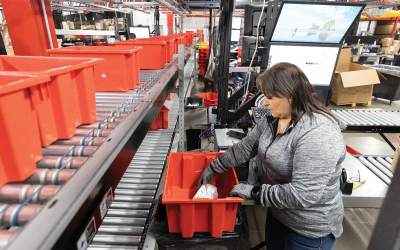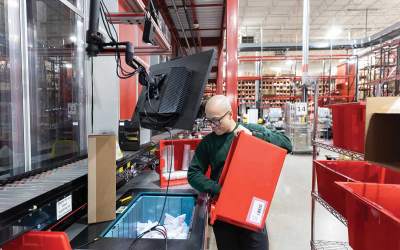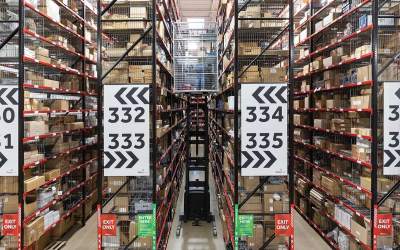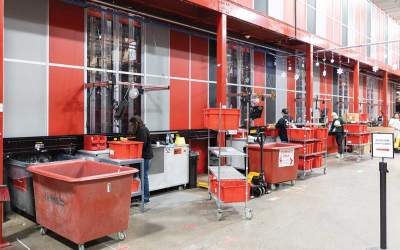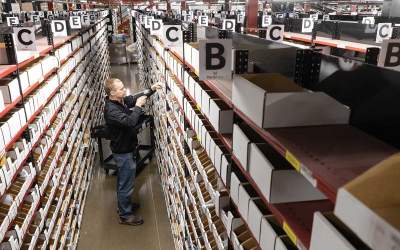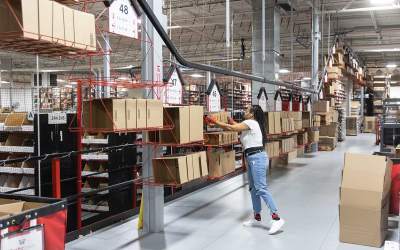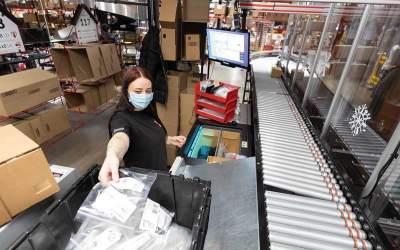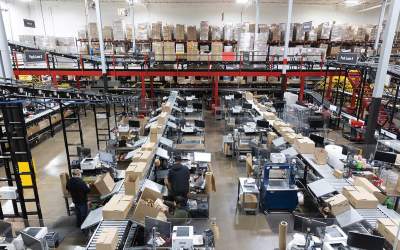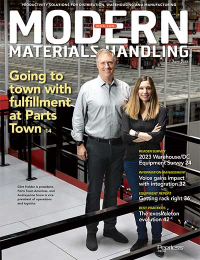Going to town with fulfillment at Parts Town
A fast-growing leader in critical OEM parts for the food service industry is using goods-to-person robotic picking to meet customer service requirements.
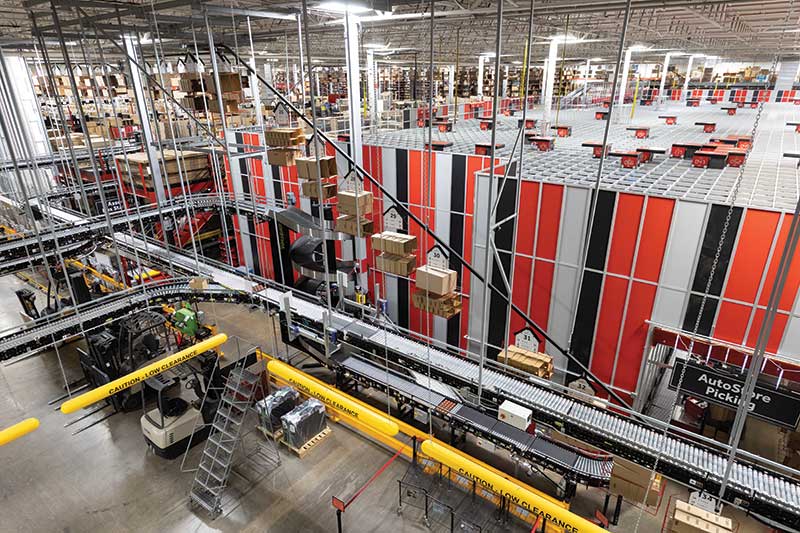
The stockings were hung by the chimney with care last December at Parts Town’s 200,000-square-foot distribution center in Addison, Ill.
OK, that’s a bit of poetic license, but colored Christmas lights were strung overhead along the conveyor system and mezzanines, and snowflakes hung from the ceiling, bringing a little holiday cheer to the DC.
“In October, we decorated for Halloween,” says Audreyanne Snow, vice president of operations and logistics (aka VP and OEM Parts Wranglers—at Parts Town, even job titles are a little quirky), adding that activities such as seasonal decorations bring a little levity to the job of getting mission-critical OEM repair parts for the foodservice, residential appliance and HVAC industries out the door. “We’re all in this together,” Snow says.
Get a closer look at the systems in place inside the Parts Town fulfillment center.
Culture, automation and innovation are the ingredients driving productivity at Parts Town’s primary DC (p. 18). They are also enabling double-digit, compound annual growth at the company, notes Clint Holder, president of Parts Town Americas. Between 2003 and 2022, sales grew from $3 million to nearly $2 billion through a combination of organic growth and acquisition.
“When you’re growing at 20% a year, it’s like adding a new small business every year,” Holder says. “We’re investing in people, technology and systems to enable this rapid growth.”
Those investments include the corporate headquarters and attached highly automated distribution center that went live in 2018. The DC has undergone several expansions since.
The layout of the facility, which uses four mezzanine areas that add the equivalent of 50,000 square feet of space, and the automation were designed to speed the flow of product from the dock to stock locations, and speed orders from picking to shipping. The goal is to meet very aggressive order cutoff times and next-day deliveries and yet still flex and scale as business continues to grow.
The automation includes:
AutoStore robotic goods-to-person storage and picking engine: The AutoStore system has been expanded five times since its 2018 installation and currently has 125 bots, 19 picking ports, eight induction ports and three quality assurance ports with capacity for 65,000 bins. While many companies aggregate their slow-moving SKUs in a high-density storage medium, Parts Town aggregates its most commonly ordered parts in AutoStore.
“As our volume increases, we can add more bots,” says Snow, adding that AutoStore handles 70% of the order volume. Parts Town estimates that with the most recent AutoStore expansion, they expect to automate about 85% of order volume. The rest comes from a narrow aisle storage area and a bin storage area for small parts, both of which handle parts that aren’t eligible for AutoStore.
Conveyor and sortation: The facility has 1.78 miles of conveyor, two shipping sorters and seven spiral conveyors that service the various mezzanines.
Print and apply: Six print and apply stations are located in packing.
Overhead box carriers: Algorithms determine the right number of box sizes for the facility. Then, based on orders, boxes are erected in a box-making area on one of the mezzanines and placed on carriers on an overhead conveyor that continues through the center of the AutoStore pick tunnel.
It is a visual, kanban system. Individual carriers are identified by a large, human-readable number; additional readable information identifies the size of the boxes in each storage compartment on a carrier. The warehouse management system (WMS) tells order selectors what boxes they need for upcoming orders, they then remove them from the carriers as they circulate through the pick tunnel. If they don’t get a box on the first pass, they can get it the next time it comes around.
All told, the facility manages 165,000 SKUs and processes 11,000 orders and about 22,000 items per day; each AutoStore order port can produce about 200 picks per hour and up to 360 per hour at peak. Parts Town accepts orders up until 9 p.m. ET, with the promise that all orders received by the cut-off time will ship that day.
Mission critical
A visual timeline that stretches along the wall leading from the office to the distribution center tells the history of Parts Town. The company is part of Parts Town Unlimited, which includes seven divisions distributing mission-critical parts in the United States, Canada, Latin America, the United Kingdom and Europe, serving customers in 160 countries.
The company was founded in 1987 with a staff of five as a restaurant equipment parts distributor for local service companies. According to the company history, it was a grim time for the industry as “manufacturers were frustrated with declining parts sales, customers wanted better customer service, and there was no platform for e-commerce.” In spite of all that, or because of it, the company founders sensed an opportunity for a new approach.
From the start, Parts Town focused on genuine OEM parts—that is all they sell today—and customer service, getting parts where they’re needed as quickly as possible. “Small mission-critical widgets are our sweet spot,” says Holder, who was recently appointed group president of Parts Town Americas. “And our obsession is taking care of customers: When a piece of equipment is down in a restaurant or hospital kitchen, they have to get back up and operating.”
By 2003, the company was up to $3 million in annual sales and operating out of 25,000 square feet with six employees, shipping about 250 packages a day. There was no automation, no WMS and zero inventory control. “What we had was enthusiasm, engagement and a commitment to grow into something that was unique and special,” says Holder.
By 2008, sales had reached $12 million, and operations had moved first into a 60,000-square-foot building and then into 150,000 square feet with gravity conveyor, a WMS, but no automation. Then, 2017 saw the addition of a shipping conveyor and plans to install AutoStore. Instead, the first AutoStore was installed in 2018 in the new Addison facility. The first iteration was 21 bots and 15,100 bins.
During that period, innovations on the sales side of the business generated growth. One was an investment to develop a large base of SKUs and in-stock inventory. Then, in 2007, Parts Town went digital with the launch of a website for online ordering followed by a mobile app in 2012. In 2008, the first full year for the website, there was little to no digital business; today, 72% of the orders come through the website or the app. Service technicians in the field can connect with Parts Town from their smart phones.
Another innovation was a 360-degree view of every part on the website: When a new SKU is received in the facility, its dimensions are captured and a digital camera takes photos of the part from every angle. That way a technician can verify that the part he or she is about to order is the part they need.
As of the end of 2022, the Parts Town Unlimited group employed 4,600 team members worldwide and was generating close to $2 billion in annual revenue, driven in large part by the revenue growth of Parts Town Americas. In addition to the 200,000-square-foot DC in Addison, Parts Town operates another 200,000+ square feet of offsite warehouse space.
Designing for service and growth
Parts Town’s move into the Addison facility was driven by the need to automate to keep up with exponential growth, customer demands for higher levels of service and evolving ordering patterns as the business transitioned to ordering online and by app.
As Snow notes, prior to the website, orders used to come into the facility all day long. Now, she says, at least 13% of the orders for that day come in between 3 p.m. and 4 p.m. and 12% between 4 p.m. and 5 p.m. The facility will accept orders to be filled that day up until 9 p.m. ET while still meeting whatever customer service level and delivery mode the customer has chosen.
“We knew we had to make investments to improve the access to information so that customers can find what they need for that downed piece of equipment,” says Holder, referencing projects like providing a 360-degree view of every part.
The company made additional investments in capacity and scalability, continually adding bots and mezzanine space as needed. For instance, during the pandemic, restaurant kitchens experienced more stress on their equipment because takeout volume was often greater than the volume when the dining room was open.
“We had to get product more quickly to the customer,” Holder says. “We designed everything so that we’d have razor thin reaction times. When we hit the order cutoff time, we clear the queue and get everything out the door that day. The customer gets the product per the delivery standard they’ve chosen. If it’s next day, it’s next day.”
The decision to add automation was never about reducing the reliance on labor, Snow notes. Rather, it was the only way to continue to scale to meet growth. “When we add more automation, our team doesn’t fear for their jobs. If anything, it attracts people to work for us,” she says.
While the space is only 200,000 square feet, Parts Town uses mezzanines to maximize the cube of the building. In addition, everything possible is done upfront to prepare an item for shipping before it’s ordered.
Receiving, for instance, takes place on a three-level mezzanine. On the ground level, palletized inventory is removed from shipping cartons, verified and scanned into totes that are conveyed to AutoStore. Parcel receipts are processed on the second level. The third level, along with an area adjacent to the receiving area, is dedicated to kitting, which in Parts Town nomenclature refers to processing parts that can ship in their transport packaging.
Box making takes place on top of another mezzanine; the ground floor space underneath consists of a carton shelving area where multi-line orders are assembled before they’re conveyed to packing.
A multi-level pedestrian pick module is set aside for small parts that aren’t eligible for AutoStore, while cartons are picked from pallets using wire-guided lift trucks in a narrow aisle storage area. The facility also has pushback and single deep pallet rack for reserve storage.
Packing takes place on a two-level mezzanine, with batch orders processed on one level and additional case sealing capacity located on another. A packing sorter is located on the ground floor.
Finally, there is one shoe sorter for shipping and a secondary pivot wheel divert ship sorter located on a mezzanine.
All told, the mezzanines create an additional 50,000 square feet of usable space above the floor.
Next steps
How does the facility in its current configuration improve the business? According to Snow, automation has improved efficiency and accuracy, and AutoStore, in particular, has added a tremendous degree of flexibility.
“In every aspect of our operations we’re faster, better and more efficient,” she says. “The record number of picks for one individual is close to 400 per hour during a very busy time. In our old manual environment, we would have been lucky to get 400 picks per day.”
The facility has room for further expansion through the addition of more AutoStore bots or equipment on under-used mezzanine space. However, Holder notes, the company believes that continued organic growth or acquisitions might necessitate another facility in another location. “Today, we’re at $2 billion in sales,” he says. “The conversation we’re having now is what does our network look like if we get to $5 billion? That may require another node.”
Holder adds that through acquisition, the company now has offices in areas outside of the Chicago area, so those regions might be part of the next expansion.
“We’re looking at other opportunities for other mission-critical, small-order parts, with mission critical being the key attribute,” he says. “We can now leverage our digital platform and the distribution capabilities we’ve developed through this facility.

Article Topics
AutoStore News & Resources
Forklifts Parts & Equipment deploying AutoStore solution to streamline fulfillment Cardinal Health at-Home Solutions automates from shelf to patient Pan Pacific Pet learns new trick GEODIS maximizes flexibility and minimizes touches DHL Supply Chain and AutoStore announce partnership expansion Robotics as a service (RaaS) catching fire Swisslog names Jens Schmale as new CEO effective start of 2024 More AutoStoreLatest in Materials Handling
Registration open for Pack Expo International 2024 Walmart chooses Swisslog AS/RS and software for third milk processing facility NetLogistik partners with Vuzix subsidiary Moviynt to offer mobility solutions for warehouses Materials Handling Robotics: The new world of heterogeneous robotic integration BSLBATT is looking for new distributors and resellers worldwide Lucas Watson appointed CSO for Körber’s Parcel Logistics business in North America Hyster recognizes Dealers of Distinction for 2023 More Materials HandlingAbout the Author
Subscribe to Materials Handling Magazine

Find out what the world's most innovative companies are doing to improve productivity in their plants and distribution centers.
Start your FREE subscription today.
April 2024 Modern Materials Handling

Latest Resources


